I don’t think I’ve ever been so instantly attached to one of the emails that’s come across the Merry-Go-Round desk in 10 years of our little publication. A documentary focusing on the now-dissolved Republic of Artsakh via the lives of four women struggling to establish and maintain a sense of home in the constantly embittered history of the unrecognized country, THERE WAS, THERE WAS NOT seemed tailor-made for my attention.
To borrow a concise history lesson from the film:
During the Soviet Union, Stalin created borders that placed Artsakh inside the newly formed Soviet Republic of Azerbaijan – even though almost all of the population was indigenous ethnic Armenians. When the Soviet Union fell, many of its former states began to fight for independence. In 1988, Armenia and Azerbaijan went to war over Artsakh. When the war ended in 1994, Armenians regained control of the region and Artsakh became an independent republic. A tentative peace lasted 30 years.
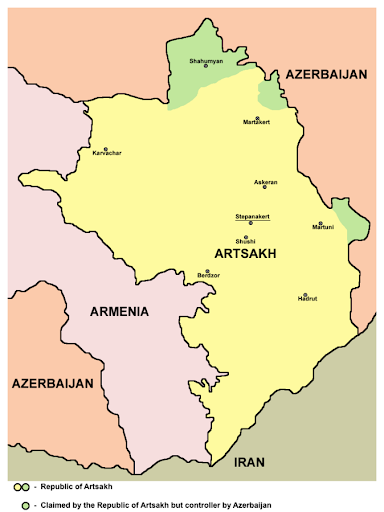
In what is undeniably one of the most captivating experiences with documentary I’ve had the pleasure of being privy to, THERE WAS, THERE WAS NOT begins in 2018, introducing us to Sosé Balasanyan, an accomplished Judoist who dreams of representing Artsakh on the Olympic stage, Siranush Sargsyan, a political candidate running for a position on the all-male city council of Stepanakert in order to champion issues important to the women of Artsakh, Sveta Harutunyan, a de-miner performing tireless work to safely remove mines left over from the wars of the ‘90s, and Gayane Hambardzumyan, founder of Artsakh’s Women’s Center, dedicated to fighting for equality and helping women escape abusive situations.
In 2019, Azerbaijan institutes a blockade on Artsakh that gradually cuts off electricity, food, gas, and medical supplies under the guise of “environmental concerns” around alleged illegal mining. Things tragically escalate in 2020 as the Aliyev regime, backed by Turkey, begins a brutal assault on Artsakh after fabricated accusations of Azeri citizens being harmed at the hands of “Armenian” mines, abruptly halting the lives these women have been fighting so diligently for.
Three years later, Artsakh is completely ethnically cleansed of its Armenian population, the Republic officially dissolved soon after.
I do not recall a single non-Armenian person saying a word at the time.
While it may be up to Armenians to continue to demand that our story be heard, I hope that you’ll take up the mantle of listening to such a beautiful, moving, heartbreaking, and quietly hopeful story as THERE WAS, THERE WAS NOT.
It was my absolute honor to get to speak with director Emily Mkrtichian about the film, its characters, the visceral immediacy of the conflicts facing the production, and the challenges and triumphs of connecting with and celebrating Armenian heritage as members of the diaspora.
This interview has been edited for clarity and content.
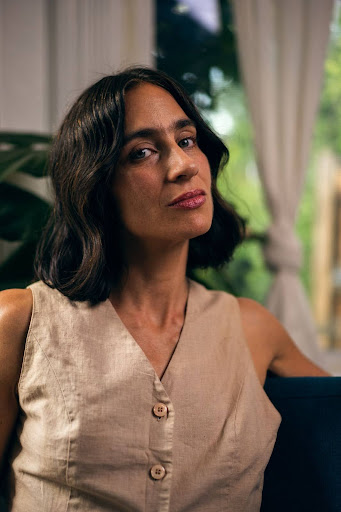
Photo Credit: Chris Natalie
First of all, right off the top, I loved this documentary. I was really genuinely blown away, and it was also so exciting just receiving the press materials, because at this specific moment of my life, I’m a diaspora Armenian that’s just starting to learn Armenian.
Emily Mkrtichian: Whoa! So cool!
Yep, yep, pari irigun to you …
EM: Oh! Bari yereko!
I’m Western dialect.
EM: Oh, cool, you’re learning Western, that’s awesome!
Yeah! And what kind of got me interested in finally accessing more of a connection to my Armenian heritage was the 2023 dissolution of Artsakh, when I saw that no one really cared except Armenians, so …
EM: So true.
And I believe one of the producers of the film is the AGBU, who actually sponsors the AVC, Armenian Virtual College, where I take classes.
EM: Oh, they do, that’s awesome, that’s really cool! Yeah, AGBU’s great.
That’s kind of my journey to this film, and I loved it, and I’m really happy to talk to you. To start I was kind of wondering, what’s your diaspora story, because I believe you also moved to Armenia at some point, right?
EM: I love that. I grew up in Seattle, which doesn’t really have much of an Armenian community, and I heard Armenian in the home growing up, but didn’t speak it. So, when I was in grad school, I found myself gravitating towards creative nonfiction writing, and that as a way to kind of explore memoir and past, and I was originally very interested in stories of, like, post-coloniality, and then I kind of realized that my own history had this aspect to it as well—like, this whole cultural memory and a rupture, and so I went to Armenia.
I did Birthright Armenia, I ended up working at Bars Media Film Studio, which is the first documentary studio in Armenia, with some really incredible people, and thought I was going for three months, but ended up staying for six years—worked at the film studio for almost three years before leaving to kind of start making my own work. That’s even how I got into film, so my whole career in filmmaking has kind of been, like, a personal journey in relation to this place and this history.
And I learned to speak fluently when I lived there, which is—I, like, really applaud you, it is hard, I’m trying to teach my kid right now.
It’s a very difficult language, and what they don’t tell you about learning Western Armenian is that most people end up speaking Eastern.
EM: It depends, like, you know, if you’re learning it to be able to communicate in modern Armenia [Eastern], or to, like, save this language that’s really a dying language [Western].
Well, yeah, because I saw that there was an LA Times piece on how, like, Western Armenian is a dying language. [Editor’s Note: It was actually LAist]
EM: It is.
By complete happenstance, my best friend’s mom growing up happens to speak Western Armenian, so when I heard anything, it was Western Armenian, so it was cool to sort of find myself in that lineage.
EM: That’s very cool.
Are you still currently based in Armenia?
EM: No, right now I’m based in Salt Lake City, Utah, where I teach at the University of Utah. I teach filmmaking here, and then I spend my summers in Armenia, so I have my own version of kind of splitting time between the two places.
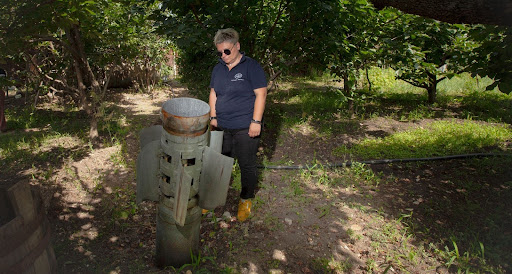
I also watched MOTHERLAND [Mkrtichian’s documentary short focusing on an all-female Artsakh de-mining crew] after I watched this, to kind of get the background. Obviously there are a lot of similarities and throughlines there. Did the start of THERE WAS, THERE WAS NOT come from that work on MOTHERLAND and community?
EM: Yeah, yeah, it did. As you know, that film is kind of me being embedded with the first group of women who are able to go out and remove landmines in Artsakh. And I think when I originally went to tell that story, I was interested in them as these kinds of feminist leaders and trailblazers, and when I got there, it was just so much more complicated than that. These were all single mothers who had stepped up to take this well-paying position to care for their families and keep their community safe. As someone who grew up in the West, there was this kind of simplification that I was doing, and they were so much more interesting, and the ways—like, especially post-conflict, that they were able to be kind of the invisible glue of their communities and drive towards a better future was just really fascinating, and I just had the instinct that it was a future … That there was a bigger story to be told.
And obviously Sveta in THERE WAS, THERE WAS NOT still works as a de-miner. Was she briefly in MOTHERLAND? I thought I caught someone that looked a little bit like her, and I was like, “Oh! Wait a minute!” Did you meet her through that?
EM: I met her through that, yeah. She wasn’t in the team that I embedded with, but she was in a second team. I think there were a total of two or three teams, so I met her through that experience, and we stayed in touch.
After MOTHERLAND had wrapped, had that directly inspired you to start telling this larger story of community, and building home and community after war and conflict?
EM: Yeah, exactly. I kept coming back and looking for kind of an expanded view, so I was looking for women across different ages and professions who were, in their own way, fighting for a better future.
How did you meet the other members of the cast? It sounds like you met Sveta first, right?
EM: Yeah, I met Svet first, and then Siranush and Gayane I met through mutual friends. And Sosé, I was teaching a filmmaking workshop for high school kids, at this kind of technology center in the capital city of Artsakh, and they were actually like, “Oh, we really want to make a documentary about this. There’s this girl, and she does judo, and she’s a champion, and she’s gonna go to the Olympics,” and I was like, “Oh, wow, cool,” and we met Sosé, and I was just like, “Wow,” like, she needs a movie, you know? Sosé needs her own movie.
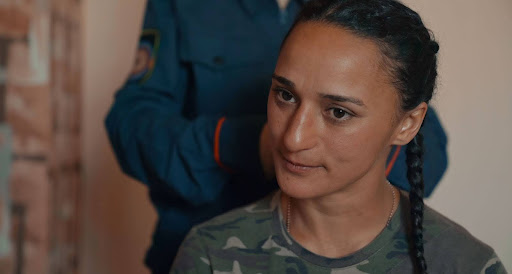
As we see in the film, it adds to this metatextual larger theme of there was, there was not, or a future or story that’s drastically changed or altered, because obviously you hadn’t planned on the 2020 attacks, but this was taking an entirely different path before that, right?
In terms of what you were trying to accomplish—the entire film’s great, but that 2018 part really blew me away, because I had never quite seen a documentary like that. For people who are about to see this film, it’s, like, so elliptical, or poetic—it really lets you ease in, and it also trusts its audience in a way that I don’t often see in documentaries. Like, for, Gayane’s story, one of the biggest moments that I walked away with is when she’s showing pictures from her past, or of her family, but there’s no narration, and I really appreciated that you allow the audience to, you know, fill in the blanks that way. It really makes for a more engaging viewing experience, so that really struck me.
Are there sources outside of film that influence you, or were influencing at that time, that kind of allowed this very unique documentary style?
EM: Thank you. I think, especially in teaching film, and thinking about film, and talking about film, one of my biggest soapboxes is that these are all really normal and accepted methods in fiction filmmaking. We have the same tools at our disposal when we make nonfiction work, so why would we not trust our audience in the same way that a fiction film does?
When I teach classes, there’s kind of this expectation that students come in with that a documentary is there to teach you something, and it’s there to be truthful and informative, and in fact, the nature of reality is not objective and truthful and informative! It’s much more beautiful than that, and I think the coolest thing about documentary film is that it has this task of representing the real world. In classes a lot, I talk about the fiction that is the truth, you know? I filmed this movie over 10 years, and it’s 94 minutes long. So, how can I relay some version of truth to you? That is so complex and literally spans the life and dissolution of a country in that time. How do I convey that to you in the way that I experienced it, you know? And how do I use emotion to express the reality of this place and these people? There’s such a beautiful, observational vérité tradition of filmmaking, and even more experimental, nonlinear, nonfiction filmmaking that were absolutely examples for me while I was making this film. But I think, again, a lot of the examples that I’ve cited in making it are from fiction filmmaking, not necessarily from documentary.
I think it also relates to the archivist vs. the concept of the Archive—that there’s sort of this common understanding of documentarians as just archivists, whereas this film especially struck me as contributing to this larger, living, breathing Archive. This sort of cerebral concept of—as you’ve stated, your artistic focus on memory, identity, place. A documentarian that I really like, Les Blank, he also has made a lot of strides towards establishing a larger Archive, which I think is amazing.
EM: Absolutely.
What were some of the nonfiction inspirations or interests that you mentioned?
EM: I mean, I love Les Blank, of course. Such a true poetic vérité filmmaker, and again, like, never, never underestimating the audience, ever, you know? I really admire Chantal Ackerman, who does both fiction and nonfiction, but, you know, is in a tradition of slow cinema, and allows things to kind of unfold and explain themselves. There are some references in the Armenian film world as well. Right now the Center Pompidou is doing a retrospective of this filmmaker, Harutyun Khachatryan, who is also kind of in this slow cinema tradition, but in nonfiction filmmaking, and his work is really, really beautiful, and a little obtuse—hard to crack in its complexity, which I really appreciate. So I think there’s also parallels for this within our own filmmaking tradition.
We can whip out the Criterion subscription and check them all out!
EM: [Laughs]
We talked about Sveta a bit. So had she known Gayane through—I believe Sveta had escaped an abusive marriage, right? That’s Gayane’s work?
EM: Mm-hm. Mm-hm.
Had they known each other in Artsakh before the film, or had they interacted?
EM: So, in the way of, like, small towns, everyone kind of knew of each other, but did not know each other … As you’ll notice in the film, all four women are so different—some of them were cool, some of them were, like, oil and water, you know what I mean? They all move each other, because there’s a lot of gossip—everyone knows of everybody, and the communal context, but none of them were, like, acquainted as friends.
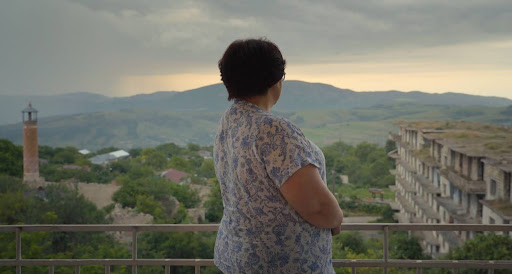
Oftentimes, Gayane mentions that the conservative government of Artsakh had historically been harassing her and her family due to her work. Was there any fallout or conflict experienced by highlighting her?
EM: You know, there was a lot … I think one thing that the film does that I’m proud of is it documents the real situation for women in that place. At that time, there was a lot of discouraging people to say anything bad about Artsakh, because the idea was that it could be used against us. And I think what I learned from these women is they had a really strong conviction that if you don’t speak up about something, it’s never gonna change, you know? That these are kind of tools of fear that are being used against us so that we don’t work towards change in our lifetimes. What was so extraordinary about all of them is that they weren’t afraid, and they weren’t afraid to bring attention to things that they thought should be better and shouldn’t be the way that they were.
As someone attempting to kind of reconnect, or connect for the first time, with an Armenian heritage, it’s hard to juggle the fact that there are just, like, social realities that are—for lack of a better word—set in the past, or like, you know, blatantly misogynistic!
EM: Yeah, absolutely.
Especially Siranush’s story. She’s trying to pitch herself as a candidate and the man she’s talking to is immediately just like, “Oh, you’re beautiful!” It’s like, oh, that’s what we’re dealing with here. How do you navigate a love for the culture with its unfortunate realities?
EM: I think sometimes we’re taught that we have it so good here in America, but every place is dealing with the patriarchy, you know? Every place is dealing with injustices, and at least in Artsakh and Armenia, they’re upfront with you about it. I feel like sometimes in the U.S, they’re like, “We’re all about women,” but it’s slow—like, actually nothing is set up for you to succeed, to have childcare and pursue a career. But [in Armenia and Artsakh] they’re just like, “Actually, we don’t believe in those things!” So, you know, I appreciate the honesty!
As with everything, there’s a really complicated relationship to that, because these places are small communities that are very enmeshed and embedded with each other, which leads to hard things, like … I don’t know if you experienced this in your home growing up, but it definitely was present in my home and exists in the larger Armenian culture—like, a lack of privacy, you know? Everyone’s in each other’s business. There’s kind of a knownness. You have to be prepared to be known in a really specific way. And that can be uncomfortable, of course, but there’s also something really beautiful about that. There’s something that, when I bring my kiddo to Armenia, and people are, like, directly interacting with him, and asking him questions, they’re up in my business, but in the best way, where I’m like—that’s fine, you’re like, kind of a random part of my family. So, I think there’s, like, positive and negative sides to it.
You had mentioned earlier that Sosé was someone people were like, “Oh, we gotta tell a story about [her],” and as much I loved meeting all the characters, she was the one that stuck with me as well. Obviously she has such a fascinating story, but it mentions that she was the only female soldier on the front lines [during the 2020 defense], but I believe that earlier we saw—didn’t we see Sveta’s daughter doing military graduation?
EM: Yeah.
Was it just that no one else wanted to go to the front lines, or wasn’t allowed to, or …
EM: So there are military high schools, but, you know, even there it’s kind of weirdly segregated—like, she really idealized, like, being a police officer, that’s kind of what she wanted to do, and a lot of those military academies were feeding into that. But, you know, I went to her graduation, and the girls did a choreographed dance in skirts, and, like … There was still kind of—
Still a bit of a divide.
EM: Yeah, there’s still a divide. But in general, Artsakh was more of a militarized state. The presence of the army was huge, like it was present in day-to-day life that there was this military reality. When it came down to it, when the war was actually starting, there were few women who were participating. And now post-war, there’s a whole generation of young women who saw that happen and are receiving military training—like, real military training, ready to defend if anything happens, which I think is really interesting.
I believe at the end, Sosé’s shown to be educating a class of girls on how to load the rifle, right? So, that’s cool that she’s continuing that.
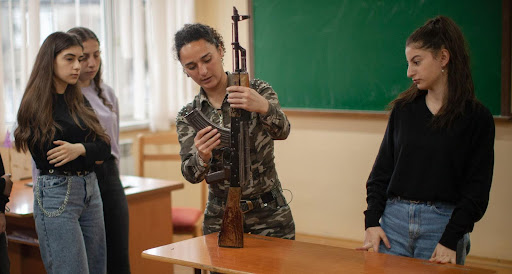
This first half, we’re meeting all these characters. Going back then, if you can still access that mindset, what had sort of been shaping in your mind as to how this original documentary was going to develop—or what kind of thesis were you working toward?
EM: So, over those first four years, I was actually working towards a large-scale art installation that an artist was making based on these four women’s stories. So we were in conversation with the women around how they saw themselves—what was the story that they were telling about themselves, and making these large-scale portraits of them in abstract ways as kind of an opposition to how they were seen by their society, which was kind of … Yeah, there was an erasure of them and their work. Then when the 2020 war started, of course, that just … disappeared. Like, everything I thought that the film was gonna be disappeared.
I’m lucky enough that most of the film was shot by me, and in terms of, like, framing, pacing, intimacy, that was all there in the first half of the film. The way that the film was shot was still in my style, still through my eyes. But the actual narrative arc of the film completely transformed.
It’s almost like a found footage horror film when it shifts to everyone running down the stairs. And then that bomb was so close! I mean, that must have been horrifying. What was your own experience, or what was the crew’s experience, with the uncertainty of when and how to evacuate? It seems like there was Armenian backing. Like, was the Armenian government particularly invested in getting you guys out of there, or was it kind of you were just in there with the rest of them?
EM: I was in there with the rest of them. It was pretty much a free-for-all. I was, like, part of helping the Ministry of Foreign Affairs kind of gather and keep track of the international journalists, because there were hundreds of people arriving all the time. So I was part of a small group of people who volunteered—a bunch of friends of mine became, like, fixers, who because they were multilingual and knew the place, would end up taking these journalists around. We had a group chat where people would talk about what was happening, and if they were evacuating, and if they were staying.
But on the whole, it was an extremely dangerous conflict for civilians. It was one of the first conflicts where drones were really the primary mode of attack, and long-range missiles. So it was all through the air, right? There didn’t have to be troops on the ground anywhere near you for you to be in a lot of danger. And I remember I had received the Sundance Institute grant on, like, the second day of the war, and the person who was heading the Institute at the time was a long-time journalist, and they did a quick analysis for me a week in, and wrote me this long email that was, like, “We really recommend that you evacuate. We have not seen a conflict this dangerous before,” and like, VICE evacuated.
Oh, wow.
EM: VICE is this outlet that you’re just, like—they are trying to die, they’re always putting themselves in a lot of danger, and they had evacuated themselves because they thought it was too dangerous to be present. So, there was no official guidance on that. It was really something that we had to learn and navigate on the fly. Now this is the kind of conflict that you’re seeing in the world. It’s extremely dangerous.
From your experience, was this Artsakh’s first experience with modern warfare in terms of this new legacy of just fully remote destruction?
EM: I think it was the world‘s first experience.
Yeah, that’s heavy—and hey, I mean, this documentary, better than VICE, is what I’m hearing right now, so.
EM: [Laughs] Yeah, yeah.
And then it transitions. I mean, thankfully, everyone escapes—or, well, Sveta stayed back?
EM: The film doesn’t document all of the ins and outs, but Sosé stayed the whole time. Myself. Siranush and Svet went back and forth several times. And then Gayane evacuated, I think, two weeks into the conflict.
Her, in particular, there’s this portrayal of her finding temporary rehousing in Armenia. Since you had been based in Armenia, and then were spending a lot of time in Artsakh as well … I know this is, like, a controversial and heavy question, but what was your experience with, or how do you think Armenia handled this, in your opinion?
EM: I mean, poorly but necessarily so. I think it’s been worse in the aftermath—they’ve neglected to give proper care and resources to displaced people and currently are negotiating in very scary ways with neighboring countries that don’t really want us to exist.
Yup!
EM: But again, Armenia is a small country [with] very few resources. And they went up against an oil-rich country [Azerbaijan] and a superpower [Turkey], so … I remember there’s a scene in the film where Sosé says, like, “We fought the world’s most modern weapons with this,” and she’s holding an AK-47 from the 1970s, and I think that kind of tells you everything there is to say about this conflict.
I believe Pashinyan [the current, largely controversial Prime Minister of Armenia] only appears in, like, the fuzzed-out background of one shot on a TV. And I thought, “Hmm, maybe that’s saying something about how he handled this conflict,” and then it seems like you somewhat corroborate that thought.
EM: Actually, I specifically told Siranush from the film that I wouldn’t give him screen time. Like, she was very upset, and one of her conditions was, like, I don’t want to see him on screen.
Wow. OK.
EM: I don’t want to hear his voice. So that was, like, the compromise.
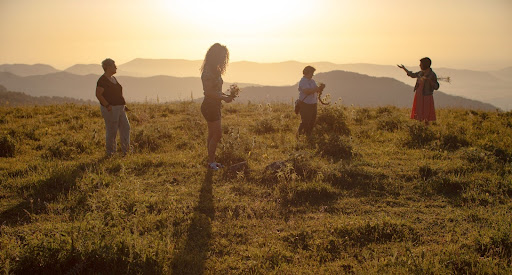
In 2023, did you have any inklings of trying to continue this story during that time, or was it—I mean, it was over so abruptly, had you thought of returning to capture the next leg of the conflict?
EM: We were actually finishing the edit in 2023, and we had, like, gotten a cut that we were starting to submit to festivals … I think we were submitting in, like, October, and so the ethnic cleansing happened, like, as we were finishing the film.
I’ve been asked about that—is there another film to be made, or would you have continued? And I think, ultimately, because I’d already been working on it for 10 years, it felt coincidental that the entire place was actually lost at the last moment of finishing the film. But I do think it’s the correct place to leave the film, it’s the reality of what happened … I think it’s the right place to leave the ending.
Had you had any interactions with Azerbaijan and Aliyev, or mercifully, did it not come up against them in any way?
EM: No, mercifully not. I mean, besides their bombs and weapons.
Well, right, yes, OK, yeah, sorry. [Laughs]
EM: [Laughs]
I meant more, like, did they ever try to, like—I don’t know, gag the film or anything?
EM: No, you know, it was just me for so long. In screening the film at film festivals, we have had some attempted censoring.
But you’ve fought through. There’s a quote at the end: “They vowed to never forget and always tell the story, because their stories were the only power they had left.” You are vocal about the power of story and myth as your gateway into Armenian identity, but that’s quite a bittersweet quote to end the film on. How has your relationship with that quote, or with the power of story and myth changed, if it has at all, over the course of this process?
EM: The loss of Artsakh remains devastating for me, and … Again, like, as someone who has this kind of displacement and loss in their lineage, it feels like an echo of something that I was taught about as a young child, as I grew up, as a possibility, but never really believed could be possible for me to witness in my lifetime. In the face of that, there’s a real question of: What do we do? I’m, as an individual, even an artist, someone who made an entire film about all of this, I don’t have any illusions that that is something that could actually make material change in the world, you know?
And in some ways, as people who make art, it’s not necessarily our job. Like, we want to move and shift culture and bring attention to things, but the ways that these big decisions—geopolitical conflicts—are started and ended, don’t rest on our shoulders. But it brings up the question, what do we have? Like, what power do we have as women, as artists, as storytellers? And I think story is a way to resist erasure. It’s a way to remember and a way to transmit into the future, so that we don’t forget.
In my own experience being Armenian, or especially being activated by 2023 to get more invested, you do sort of feel doomed, for lack of a better word, to only have your story to be, like, “Hey, please care about us.” But moving the momentum forward, there’s power in still being here—there’s power in you making this film, you know? There’s power in two Armenians talking about it, right?
EM: Yeah, what is that Saroyan quote? See …
MGRM and EM: Any two Armenians if they cannot create a new Armenia.
EM: Sometimes, in some ways, that became, like, trite to me—as like, oh, it’s funny, but, actually, as we’re having this conversation, what are we doing? What do we have the power to do? We have the power to remake a memory in a past and a future, and that is actually very powerful.
Thank you again, from the bottom of my heart, to Emily and the entire THERE WAS, THERE WAS NOT crew for contributing to such a beautiful Archive of Artsakh and for allowing me the opportunity to access it.
THERE WAS, THERE WAS NOT can be seen at the following theaters. For our primary LA readership, I’d particularly highlight the showing at Laemmle Glendale on Friday 10/17 with a Q&A with Emily.


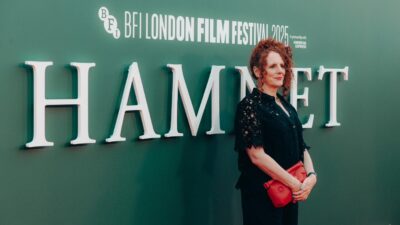
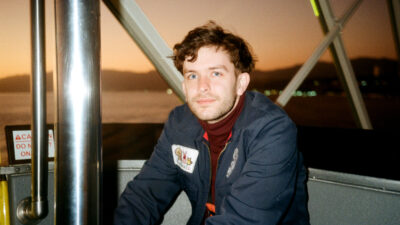
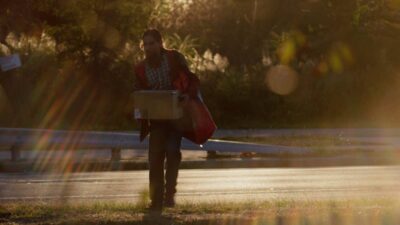
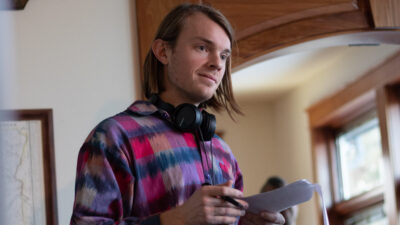

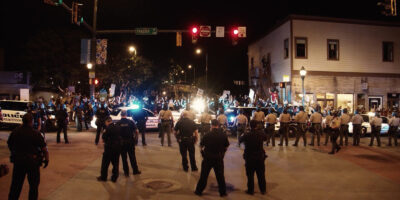
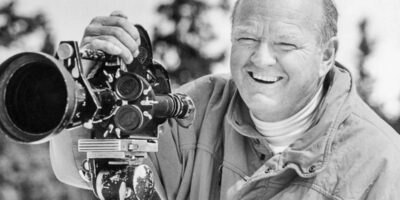
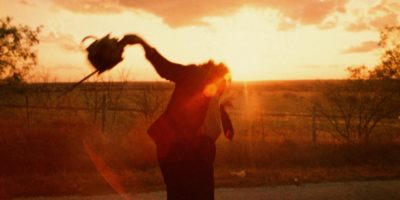
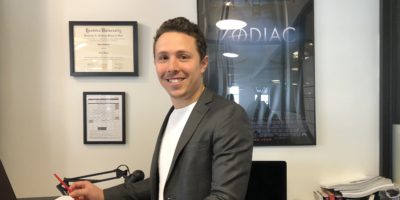
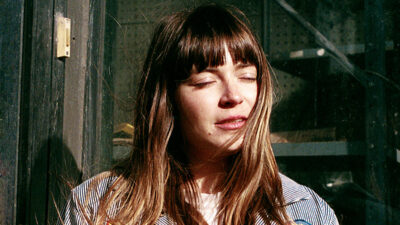
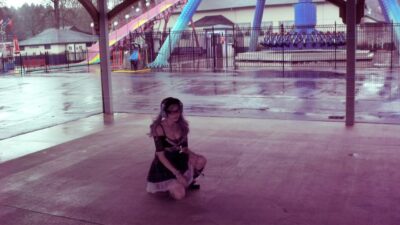
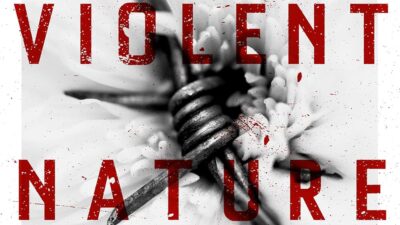
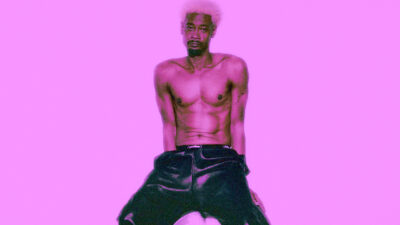
Comments